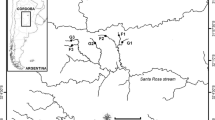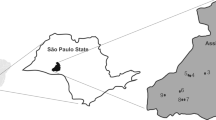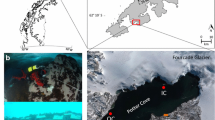Abstract
We evaluated changes in the succession process in benthic algal communities of an afforested stream by comparing them with those in a grassland stream through analysis of temporal changes in composition, structure and functional traits in a 3-month experiment. We hypothesized that sunlight intensity reduction as a result of streamside implanted tree shading reduces the succession rate and community physiognomic complexity. We selected two streams with different riparian cover (grassland and pine afforestation) for installation of unglazed tiles as artificial substrates. The tiles were collected from each stream after 23, 45 and 73 days of exposure. Afforestation produced changes in algal succession, with lower biomass, lower diversity at the beginning of the experiment, and an increase in the proportion of small, low-profile, tolerant, unicellular and stalked algae, coinciding with the predominance of Achnanthidium. However, the grassland stream contained a higher proportion of intermediate-size algae, as well as a larger proportion of high-profile algae, coinciding with the expected results. In the afforested stream, succession proceeded toward the dominance of low-profile species, that were tolerant of low-light conditions. However, in grassland streams with higher sunlight availability, high-profile algae prevailed without the displacement of tolerant forms. Overall, our results indicate that algal communities in afforested stream remain structurally simpler.




Similar content being viewed by others
References
Anderson MJ (2001) A new method for non-parametric multivariate analysis of variance. Austral Ecol 26:32–46
APHA (1998) Standard methods for examination of water and wastewater, 20th edn. American Public Health Association, American Water Works Association and the Water and Environment Federation, Washington, DC
Artigas J, Fund K, Kirchen S, Morin S, Obst U, Romaní AM, Sabater S, Schwartz T (2012) Patterns of biofilm formation in two streams from different bioclimatic regions: analysis of microbial community structure and metabolism. Hydrobiologia 695:83–96
Bärlocher F, Oertli JJ (1978a) Colonization of conifer needles by aquatic hyphomycetes. Can J Bot 56:57–62
Bärlocher F, Oertli JJ (1978b) Inhibitors of aquatic hyphomycetes in dead conifer needles. Mycologia 70:964–974
Biggs BJF (1996) Patterns in benthic algae of streams. In: Stevenson RJ, Bothwell ML, Lowe RL (eds) Algal ecology: freshwater benthic ecosystems. Academic Press Inc, San Diego, pp 31–56
Biggs BJF, Kilroy C (2000) Stream periphyton monitoring manual. Publishers NIWA for the New Zealand Ministry for the Environment, New Zealand
Biggs BJF, Stokseth S (1996) Hydraulic habitat suitability for periphyton in rivers. Regul rivers 12:251–261
Boston HL, Hill WR (1991) Photosynthesis-light relations of stream periphyton communities. Limnol Oceanogr 36:644–656
Boulêtreau S, Garabétian F, Sauvage S, Sánchez-Pérez JM (2006) Assessing the importance of a self-generated detachment process in river biofilm models. Freshw Biol 51:901–912
Branco CCZ, Branco LHZ, Moura MO, Bertusso FR (2005) The succession dynamics of a macroalgal community after a flood disturbance in a tropical stream from São Paulo State, southeastern Brazil. Revista Brasil Bot 28:267–275
Cabido D, Cabido M, Garre SM, Gorgas JA, Miatello R, Rambaldi S, Ravelo A, Tassile JL (2003) Regiones Naturales de la Provincia de Córdoba, Serie C. Publicaciones Técnicas, Agencia Córdoba, Córdoba
Cibils L, Principe R, Márquez J, Gari N, Albariño R (2015) Functional diversity of algal communities from headwater grassland streams: how does it change following afforestation? Aquat Ecol 49:453–466
Clarke KR, Warwick RM (2001) A further biodiversity index applicable to species lists: variation in taxonomic distinctness. Mar Ecol Prog Ser 216:265–278
Collins GB, Weber CT (1978) Phycoperiphyton (algae) as indicators of water quality. T Am Microsc Soc 97:36–43
Di Rienzo JA, Macchiavelli RE, Casanoves F (2011) Modelos lineales mixtos: aplicaciones en InfoStat, 1a edn. Grupo Infostat, Córdoba
Di Rienzo JA, Casanoves F, Balzarini MG, Gonzalez L, Tablada M, Robledo CW (2012) InfoStat versión 2012. Grupo InfoStat, FCA, Universidad Nacional de Córdoba, Argentina. http://www.infostat.com.ar
Díaz Villanueva V, Modenutti B (2004) Experimental analysis of grazing by the mayfly Meridialaris chiloeensis on different successional stages of stream periphyton. Internat Rev Hydrobiol 89:263–277
Dudley TL, D’Antonio CM (1991) The effects of substrate texture, grazing, and disturbance on macroalgal establishment in streams. Ecology 72:297–309
Duong TT, Feurtet-Mazel A, Coste M, Dang DK, Boudou A (2007) Dynamics of diatom colonization process in some rivers influenced by urban pollution (Hanoi, Vietnam). Ecol Ind 7:839–851
Farley KA, Jobbágy EG, Jackson RB (2005) Effects of afforestation on water yield: a global synthesis with implications for policy. Glob Change Biol 11:1565–1576
Flöder S, Hillebrand H (2012) Species traits and species diversity affect community stability in a multiple stressor framework. Aquat Biol 17:197–209
Gordon ND, Mcmahon TA, Finlayson BL (1994) Stream hydrology, an introduction for ecologists. Wiley, New York
Guariguata MR, Ostertag R (2001) Neotropical secondary forest succession: changes in structural and functional characteristics. Forest Ecol Manag 148:185–206
Hill WR (1996) Effects of light. In: Stevenson RJ, Bothwell ML, Lowe RL (eds) Algal ecology: freshwater benthic ecosystems. Academic Press Inc, San Diego, pp 121–148
Hill WR, Ryon MG, Schilling EM (1995) Light limitation in a stream ecosystem: responses by primary producers and consumers. Ecology 76:1297–1309
Hillebrand H, Sommer U (2000) Diversity of benthic microalgae in response to colonization time and eutrophication. Aquat Bot 67:221–236
Hillebrand H, Dürselen CD, Kirschtel D, Pollingher U, Zohary T (1999) Biovolume calculation for pelagic and benthic microalgae. J Phycol 35:403–424
Hlúbiková D, Novais MH, Dohet A, Hoffmann L, Ector L (2014) Effect of riparian vegetation on diatom assemblages in headwater streams under different land uses. Sci Total Environ 475:234–247
Hoagland KD, Roemer SC, Rosowski JR (1982) Colonization and community structure of two periphyton assemblages, with emphasis on the diatoms (Bacillariophyceae). Am J Bot 69:188–213
Hudon C, Bourget E (1981) Initial colonization of artificial substrate: community development and structure studied by scanning electron microscopy. Can J Fish Aquat Sci 38:1371–1384
Hudon C, Bourget E (1983) The effect of light on the vertical structure of epibenthic diatom communities. Bot Mar 26:317–330
Hulot FD, Lacroix G, Lescher-Moutoué F, Loreau M (2000) Functional diversity governs ecosystem response to nutrient enrichment. Nature 405:340–344
Jackson RB, Jobbágy EG, Avissar R, Roy SB, Barrett D, Cook CW, Farley KA, Le Maitre DC, McCarl BA, Murray BC (2005) Trading water for carbon with biological carbon sequestration. Science 310:1944–1947
Johnson RE, Tuchman NC, Peterson CG (1997) Changes in the vertical microdistribution of diatoms within a developing periphyton mat. J N Am Benthol Soc 16:503–519
Korte VL, Blinn DW (1983) Diatom colonization on artificial substrata in pool and riffle zones studied by light and scanning electron microscopy. J Phycol 19:332–341
Lamberti GA, Gregory SV, Ashkenas LR, Steinman AD, McIntire CD (1989) Productive capacity of periphyton as a determinant of plant–herbivore interactions in streams. Ecology 70:1840–1856
Lange K, Liess A, Piggott JJ, Townsend CR, Matthaei CD (2011) Light, nutrients and grazing interact to determine stream diatom community composition and functional group structure. Freshw Biol 56:264–278
Larson CA, Passy SI (2012) Taxonomic and functional composition of the algal benthos exhibits similar successional trends in response to nutrient supply and current velocity. FEMS Microbiol Ecol 80:352–362
Lowe RL, Golladay SW, Webster JR (1986) Periphyton response to nutrient manipulation in streams draining clearcut and forested watersheds. J N Am Benthol Soc 5:221–229
Márquez J, Cibils L, Principe R, Albariño R (2015) Stream macroinvertebrate communities change with grassland afforestation in central Argentina. Limnologica 53:17–25
Mátyás C, Sun G (2014) Forests in a water limited world under climate change. Environ Res Lett 9:1–10
McArdle BH, Anderson MJ (2001) Fitting multivariate models to community data: a comment on distance-based redundancy analysis. Ecology 82:290–297
McCormick PV, Stevenson RJ (1991) Mechanisms of benthic algal succession in lotic environments. Ecology 72:1835–1848
Nusch EA (1980) Comparison of different methods for chlorophyll and phaeopigment determination. Arch Hydrobiol 14:14–36
Odum EP (1969) Strategy of ecosystem development. Science 164:262–270
Oggero A, Arana M (2012) Inventario de la biodiversidad de plantas vasculares del sur de la zona serrana de Córdoba, Argentina. Hoehnea 39:171–199
Oksanen J, Guillaume Blanchet F, Kindt R, Legendre P, Minchin PR, O’Hara RB, Simpson GL, Solymos P, Henry M, Stevens H, Wagner H (2013) Vegan: community ecology package. R package version 2.0–8
Passy SI (2008) Continental diatom biodiversity in stream benthos declines as more nutrients become limiting. Proc Natl Acad Sci USA 105:9663–9667
Passy SI, Larson CA (2011) Succession in stream biofilms is an environmentally driven gradient of stress tolerance. Microb Ecol 62:414–424
Plevich J, Nuñez C, Cantero J, Demaestri M, Viale S (2002) Biomasa del pastizal bajo diferentes densidades de pino (Pinus elliottii). Agroforestería en las Américas 9:19–23
Principe R, Márquez J, Cibils Martina L, Jobbágy EG, Albariño R (2015) Pine afforestation changes more strongly community structure than ecosystem functioning in grassland mountain streams. Ecol Indic 57:366–375
Quinn GP, Keough MJ (2002) Experimental design and data analysis for biologists. Cambridge University Press, Cambridge
R Core Team (2013) R: a language and environment for statistical computing. Vienna, Austria: R Foundation for Statistical Computing. http://www.R-project.org/
Roberts S, Sabater S, Beardall J (2004) Benthic microalgal colonization in streams of differing riparian cover and light availability. J Phycol 40:1004–1012
Roemer SC, Hoagland KD, Rosowski JR (1984) Development of a freshwater periphyton community as influenced by diatom mucilages. Can J Bot 62:1799–1813
Sekar R, Nair KVK, Rao VNR, Venugopalan VP (2002) Nutrient dynamics and successional changes in a lentic freshwater biofilm. Freshw Biol 47:1893–1907
Simberloff D, Nuñez MA, Ledgard NJ, Pauchard A, Richardson DM, Sarasola M, Vanwilgen VW, Zalba SM, Zenni RD, Bustamante R et al (2010) Spread and impact of introduced conifers in South America: lessons from other southern hemisphere regions. Austral Ecol 35:489–504
Steinman AD, McIntire CD (1986) Effects of current velocity and light energy on the structure of periphyton assemblages in laboratory streams. J Phycol 22:352–361
Stevenson RJ (1996) An introduction to algal ecology in freshwater benthic habitats. In: Stevenson RJ, Bothwell ML, Lowe RL (eds) Algal ecology: freshwater benthic ecosystems. Academic Press Inc, San Diego, pp 3–30
Stevenson RJ, Peterson CG, Kirschtel DB, King CC, Tuchman NC (1991) Density-dependent growth, ecological strategies and effects of nutrients and shading on benthic diatom succession in streams. J Phycol 27:59–69
Swaine MD, Whitmore TC (1988) On the definition of ecological species groups in tropical rain forests. Vegetatio 75:81–86
Terborgh J (1985) The vertical component of plant species diversity in temperate and tropical forests. Am Natur 126:760–776
Thomson JR, Taylor MP, Fryirs KA, Brierley GJ (2001) A geomorphological framework for river characterization and habitat assessment. Aquat Conserv 11:373–389
Tuji A (2000) Observation of developmental processes in loosely attached diatom (Bacillariophyceae) communities. Phycol Res 48:75–84
Villafañe VE, Reid FMH (1995) Métodos de microscopía para la cuantificación del fitoplancton. In: Alveal K, Ferrario ME, Oliveira EC, Sar E (eds) Manual de Métodos Ficológicos. Universitaria, Concepción, Chile, pp 169–185
Villeneuve A, Montuelle B, Bouchez A (2010) Influence of slight differences in environmental conditions (light, hydrodynamics) on the structure and function of periphyton. Aquat Sci 72:33–44
Weber CI (1973) Biological monitoring of the aquatic environment. In: Cairns J Jr, Dickson KL (eds) Biological methods for the assessment of water quality, ASTM STP 528. American Society of Testing and Materials, Philadelphia, USA, pp 46–60
Wellnitz TA, Ward JV (2000) Herbivory and irradiance shape periphytic architecture in a Swiss alpine stream. Limnol Oceanogr 45:64–75
Wu Y, Antoine SE, Bowker DW (1999) Colonisation of epilithic diatom population of the river Taff, South Wales, UK. Limnologica 29:174–185
Acknowledgements
We thank the two reviewers, two editors and the editorial coordinator, who greatly improved the quality of the manuscript. This work was funded by the Agencia Nacional de Promoción Científica y Tecnológica (ANPCyT, Grant PICT 1113), Ministerio de Ciencia y Tecnología de la provincia de Córdoba (MinCyT Córdoba, Grant GRF 08), and Secretaría de Ciencia y Técnica Universidad Nacional de Río Cuarto. LCM and JM were supported by fellowships of Consejo Nacional de Investigaciones Científicas y Técnicas (CONICET), Argentina.
Author information
Authors and Affiliations
Corresponding author
Ethics declarations
Conflict of interest
The authors declare that they have no conflict of interest.
Electronic supplementary material
Below is the link to the electronic supplementary material.
About this article
Cite this article
Cibils-Martina, L., Principe, R.E., Márquez, J.A. et al. Succession of algal communities in headwaters: a comparison of pine afforested and natural grassland streams. Ecol Res 32, 423–434 (2017). https://doi.org/10.1007/s11284-017-1455-2
Received:
Accepted:
Published:
Issue Date:
DOI: https://doi.org/10.1007/s11284-017-1455-2




